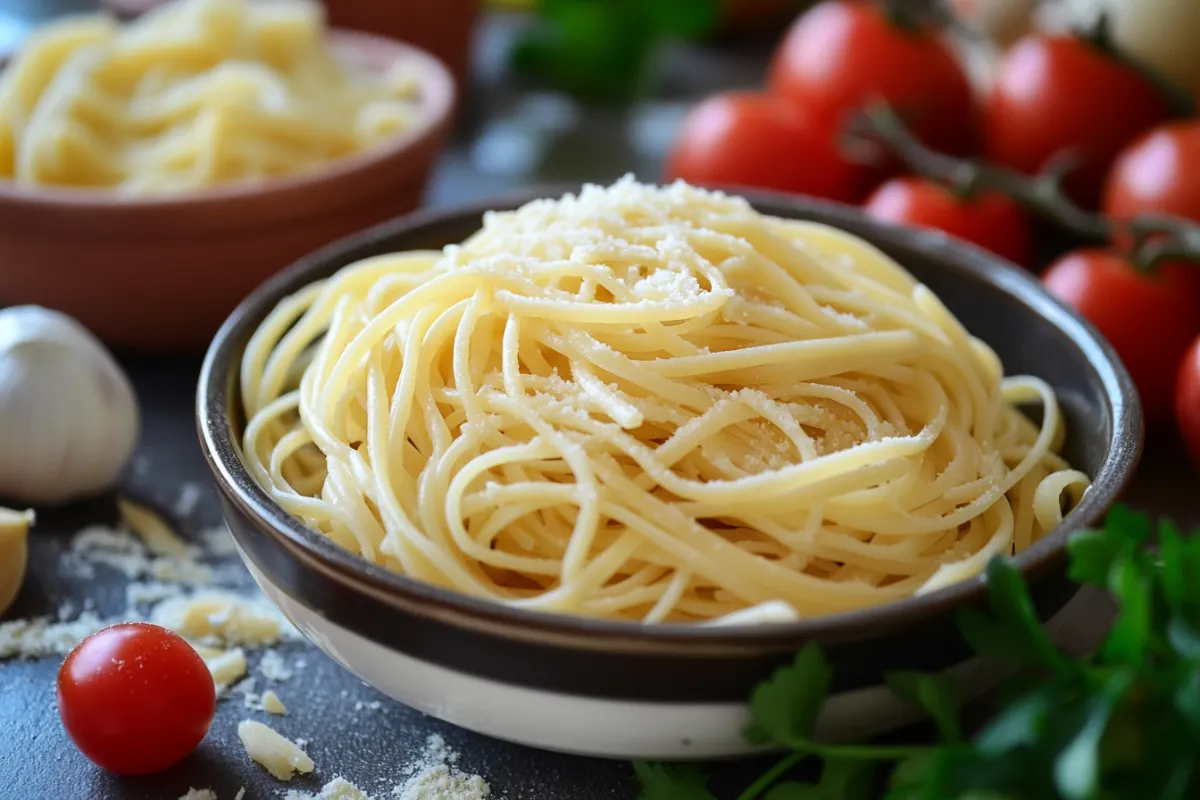Capellini vs Vermicelli: What’s the Difference?
If you’re a pasta lover, you’ve likely encountered both capellini and vermicelli while exploring recipes or browsing supermarket shelves. But Capellini vs Vermicelli—which is best for your dish? Although they look similar at first glance, these two types of pasta have key differences that affect their texture, taste, and culinary uses. So, is capellini the same as vermicelli? Let’s dive deeper into their characteristics, culinary uses, and cultural significance to answer this question thoroughly.
Understanding the differences between various pasta types is essential for any cook, whether you’re a seasoned chef or just starting in the kitchen. Even subtle differences in texture, thickness, and shape can dramatically impact the flavor and outcome of a dish. Additionally, regional variations of capellini and vermicelli add complexity, making it crucial to distinguish between them when choosing the right pasta for your recipes.
Let’s take a closer look at Capellini vs Vermicelli and how to use each in the kitchen.
Capellini vs Vermicelli: What Are They?
Capellini and vermicelli are both long, thin strands of pasta, but their origins, uses, and textures differ significantly. These thin pastas may confuse people because they share many visual similarities, but the differences in their bite and mouthfeel are distinct. So, when it comes to Capellini vs Vermicelli, it’s all about understanding these differences.
- Capellini, also known as angel hair pasta in the United States, is one of the thinnest types of Italian pasta, with a diameter of 0.85 mm to 0.92 mm. Its delicate structure makes it ideal for light sauces and broths, allowing other ingredients to take center stage. The name capellini means “little hair” in Italian, reflecting its fine, delicate appearance.
- Vermicelli, on the other hand, is slightly thicker than capellini. In Italy, vermicelli translates to “little worms” because of its slightly thicker and more robust structure. Vermicelli’s thickness can vary depending on the region. For example, in Italy, vermicelli is thicker than spaghetti, but in Asian cuisines, it is often much thinner and made from rice or starch.
Vermicelli plays a broader role across different culinary traditions. While it’s a staple in Italian dishes, vermicelli also appears prominently in Asian cuisines such as stir-fries, soups, and cold noodle salads.
Key Differences: Capellini vs Vermicelli
The primary distinction in the Capellini vs Vermicelli debate lies in their thickness, which directly affects their texture. Capellini is one of the thinnest types of pasta, with a diameter between 0.85 and 0.92 mm. This fine texture allows it to cook quickly and pairs best with light, delicate sauces. Its fragility requires careful attention during cooking, as it can easily overcook and become mushy.
On the other hand, vermicelli is slightly thicker, with a diameter that typically ranges from 1.5 to 2 mm in Italian varieties. The added thickness gives vermicelli a sturdier texture, allowing it to hold up against heavier sauces and more complex dishes. Vermicelli’s heartier structure also extends its cooking time to around 7 to 9 minutes, depending on the thickness.
These differences in texture and thickness play a significant role in determining how each pasta behaves in various dishes. Capellini absorbs light, broth-based sauces beautifully, while vermicelli can withstand rich, thick sauces and the addition of meats or vegetables.
For more details on the distinctions between these pastas, explore Delallo’s guide to capellini.
Culinary Uses: Capellini vs Vermicelli
Capellini and vermicelli serve different culinary purposes because of their unique textures. Capellini works best in dishes that highlight the pasta itself, such as simple olive oil and garlic sauces or delicate broths. It pairs well with seafood, allowing the flavors of the seafood to shine without overwhelming the dish.
Vermicelli, with its thicker and firmer structure, complements more robust sauces and ingredients. It often appears in heartier Italian dishes, such as pasta with meatballs, as well as in various Asian stir-fries, soups, and cold noodle dishes. Vermicelli can also take on different forms in Asian cuisine, such as rice vermicelli, which is a popular choice for cold noodle salads or stir-fries.
Vermicelli is also versatile enough to be used in sweet dishes, such as seviyan (vermicelli pudding), a popular dessert in South Asian cuisine. In these recipes, vermicelli’s thin, noodle-like structure is often cooked in milk and flavored with spices like cardamom, nuts, and saffron.
For more culinary inspiration, try our recipe on how to use capellini in simple Italian dishes.
Regional Variations
Although capellini maintains a relatively uniform identity across different regions, vermicelli takes on different forms depending on where it’s made. In Italy, vermicelli refers to a thicker pasta, but in Asia, vermicelli is often much thinner and made from rice, mung beans, or starch. These regional differences can cause confusion, especially for those unfamiliar with international culinary terms.
For example, Chinese cuisine commonly features rice vermicelli in stir-fries and soups, offering a soft, chewy texture that contrasts with crisp vegetables or a rich broth. Vietnamese cuisine uses vermicelli in popular dishes like bun (a cold noodle salad) or pho (a noodle soup).
In contrast, Italian vermicelli finds its home in traditional pasta dishes with rich tomato or cream-based sauces. Its firmer texture makes it ideal for holding up under the weight of heavier ingredients and sauces.
When considering vermicelli, it’s important to recognize these regional variations, as the texture and cooking methods can vary significantly based on where the pasta is made and how it’s used.
Cooking Techniques: Capellini vs Vermicelli
Due to their different thicknesses, capellini and vermicelli require distinct cooking techniques. Capellini, with its fine structure, cooks in just 2 to 3 minutes, making it ideal for quick, simple meals. It’s crucial to watch capellini closely during cooking to prevent it from becoming mushy. After cooking, toss it immediately with sauce or oil to prevent it from sticking together.
Vermicelli requires more cooking time, typically around 7 to 9 minutes for Italian varieties. Its sturdier texture allows it to stand up to heavier sauces and more complex dishes. In Asian cuisine, rice vermicelli often requires soaking in warm water before being stir-fried or added to soups.
Both types of pasta benefit from being tossed in olive oil after cooking to prevent clumping. Additionally, using a large pot with ample water helps ensure the strands don’t stick together during cooking.
Substituting Capellini for Vermicelli in Recipes
Home cooks often wonder whether they can substitute capellini for vermicelli in recipes. The answer is yes—but with some adjustments.
If you substitute capellini for vermicelli, expect a lighter, more delicate dish. Capellini’s thin structure may not hold up well under heavy sauces or complex ingredients. However, in light dishes like pasta with olive oil, garlic, or seafood, capellini can successfully replace vermicelli without compromising the dish’s flavor.
On the other hand, substituting vermicelli for capellini results in a more substantial dish. Vermicelli’s thicker texture allows it to absorb more sauce, making it a great choice for recipes that call for a heartier pasta. Just remember to adjust the cooking time, as vermicelli requires more time to reach al dente than capellini.
For more pasta substitutions, check out our ultimate guide to Italian pasta.
Nutritional Differences and Health Considerations
When comparing the nutritional profiles of capellini and vermicelli, you’ll find minimal differences. Both are rich in carbohydrates and provide similar amounts of protein, particularly if they are made from durum wheat semolina. However, vermicelli can also be found in gluten-free varieties, especially in Asian markets where rice-based vermicelli is common.
A 2-ounce serving of either pasta contains about 200 calories, 40 grams of carbohydrates, and 7 grams of protein. Whole wheat versions of both pastas provide more fiber and nutrients, making them a healthier option for those looking to increase their intake of whole grains.
For people with gluten sensitivities, vermicelli’s gluten-free alternatives offer more versatility. In contrast, capellini, typically made from wheat, may not be suitable unless labeled as gluten-free.
Frequently Asked Questions (FAQs)
1. Is capellini the same as angel hair pasta?
Yes, capellini is often referred to as angel hair pasta, particularly in the United States. The names are used interchangeably, though some regions may classify angel hair as slightly thinner than capellini.
2. What is the best substitute for vermicelli?
Thin spaghetti or capellini can serve as substitutes for vermicelli in Italian dishes, though the texture will differ slightly. For Asian recipes, rice noodles or rice vermicelli offer a closer match, maintaining a similar thinness and consistency.
3. Why is vermicelli used in Asian cooking?
Asian cuisine uses vermicelli for its thin, noodle-like structure, which absorbs flavors without becoming mushy. Its versatility allows it to appear in stir-fries, soups, and cold noodle dishes, making it a staple in many Asian recipes.
4. Can you use capellini in cold dishes?
Yes, you can use capellini in cold dishes like pasta salads. Its delicate nature pairs well with light vinaigrettes, fresh vegetables, and herbs. To prevent the pasta from sticking, rinse it in cold water immediately after cooking and toss it with olive oil.
Conclusion: Capellini vs Vermicelli
In conclusion, while capellini and vermicelli may seem similar at first glance, their differences in thickness, texture, and culinary uses make each one unique. Capellini excels in delicate dishes with light sauces, while vermicelli is versatile enough to be used in a wide range of Italian and Asian recipes. Whether you’re preparing a light pasta dish or a hearty stir-fry, understanding the nuances between these two types of pasta will help you choose the best option for your dish.
For more pasta-related insights and delicious recipes, check out our ultimate guide to capellini pasta.


1 thought on “Is capellini the same as vermicelli?”